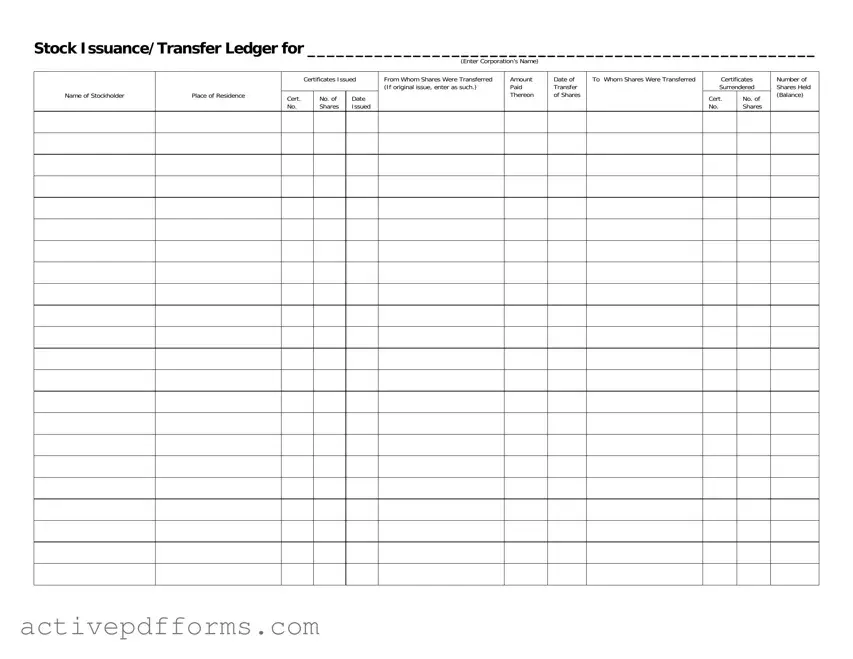What is the purpose of a Stock Transfer Ledger form?
The primary purpose of a Stock Transfer Ledger form is to meticulously record the details of issuances and transfers of a corporation's stock. This ledger provides an organized way to maintain a permanent record of stock ownership changes, including the issuance of new shares and the transfer of existing shares between shareholders. It helps in ensuring the accuracy of the corporation’s shareholder records, facilitates compliance with legal and regulatory requirements, and serves as a vital document for auditing.
How is information about stock issuances and transfers recorded in the ledger?
In the Stock Transfer Ledger form, information about stock issuances and transfers is recorded systematically. Each entry includes the name of the stockholder, their place of residence, certificate numbers (both issued and surrendered), the number of shares issued or transferred, from whom shares were transferred (or "original issue" if applicable), amount paid on the shares, date of transfer, and to whom shares were transferred. Additionally, it includes a tally of the number of shares held (balance) after each transaction, ensuring a clear, ongoing record of share ownership.
Who is responsible for maintaining the Stock Transfer Ledger?
The responsibility of maintaining the Stock Transfer Ledger generally falls upon the corporation's corporate secretary or another designated officer. This individual ensures the ledger is accurately updated following each stock issuance or transfer, maintaining confidentiality and security of the shareholder information. It is vital for the ledger to be kept up-to-date to reflect the current ownership accurately and comply with legal stipulations.
Why is it important for a corporation to keep a well-maintained Stock Transfer Ledger?
Keeping a well-maintained Stock Transfer Ledger is crucial for several reasons. Legally, it is necessary for confirming the corporation’s compliance with federal and state securities laws. Operationally, it helps in the management of shareholder relations and facilitates the accurate calculation of dividends. Additionally, it serves as an essential record during audits, providing verifiable evidence of stock issuances and transfers. A comprehensive ledger supports transparency and accountability in the corporation’s operations.
Can changes to the Stock Transfer Ledger impact the corporate governance?
Yes, changes to the Stock Transfer Ledger can significantly impact corporate governance. As it records shifts in share ownership, these changes can alter voting powers within the corporation, possibly affecting the outcome of shareholder meetings and the election of board members. A precise and up-to-date ledger ensures that ownership and voting rights are accurately recorded, fostering fair and transparent corporate governance practices.
What actions should be taken if discrepancies are found in the Stock Transfer Ledger?
If discrepancies are found in the Stock Transfer Ledger, immediate action should be taken to investigate and resolve the issues. This may involve reconciling the ledger with actual share certificates, bank statements, and other financial records. It could also require consulting with individuals involved in the transactions, like shareholders or brokers. Prompt correction of discrepancies is critical to maintaining the integrity of corporate records and ensuring compliance with legal standards. If necessary, legal or accounting professionals should be consulted to assist in resolving complex issues.

